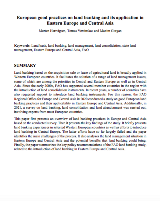Land tenure underlies most development efforts and initiatives, including those related to introducing green agricultural practices and the transformation of food systems. Since agricultural land is one of the main factors of production and the basis for any human activity, clear and secure tenure rights over land represent an essential element of – and basic precondition of – sustainability.
On the other hand, insecure tenure rights, disputes and conflicts over land, and unequal access to land and other natural resources can jeopardize development efforts and often pose significant barriers to the achievement of development objectives.
Overview and FAO contribution
Farm structures with excessive land fragmentation and very small farm sizes hinder farm productivity and competitiveness, hamper the introduction of more sustainable and environmentally friendly agricultural practices and may lead to land abandonment. It is essential to address these structural problems while strengthening tenure security and securing equal access to land. Land management instruments such as land consolidation, land banking, facilitation of lease agreements and an active management of state-owned agricultural land can help address these challenges holistically and comprehensively while contributing to broader development objectives.
Europe and Central Asia
Farms in most FAO programme countries in Europe and Central Asia (ECA) are predominately small family farms, with only a relatively few large corporate farms. Land fragmentation is often excessive, and land abandonment is widespread. Around the year 2000, FAO began to document and address problems in this area.
Most countries in Western Europe have long traditions of land consolidation and land banking. Initially, the main objective was to facilitate local agricultural development by reducing land fragmentation and facilitating farm enlargement on a voluntary basis, often in connection with the improvement of the local agricultural infrastructure. Since the 1980s, countries in Western Europe have started to apply land consolidation in a multi-purpose approach, i.e. pursuing at the same time agricultural development and such public objectives as climate change adaptation and mitigation, nature restoration, afforestation and environmental protection.
Since 2004, FAO has in the region supported the introduction of land management instruments and the building up of national programmes through
- normative work;
- country-specific support for implementing pilots, preparing policies and legislation and ensuring initial capacity development; and
- the establishment of a regional technical network, LANDNET, on such technical topics as land consolidation, land banking, land market development and others.
Land consolidation and land banking can also be relevant outside of Europe and Central Asia, strongly contributing to integrated local rural development and the achievement of several SDG targets. Land consolidation is already applied outside of Europe, mainly in Southeast Asia but also in North Africa.
Video from MAINLAND project in North Macedonia (2022)
Publications

Lessons learned from the introduction of land consolidation in North Macedonia during 2014-2023
2023
This publication aims to document the lessons learned from the introduction of a land consolidation instrument in North Macedonia during the period 2014–2023. The purpose is to share the experiences with land consolidation, which will also be of great relevance for other countries in Europe and Central Asia and beyond that are in the process of introducing land management instruments such as land consolidation and land banking.

Analysis of land abandonment and development of agricultural land markets in the Republic of NorthMacedonia
2023
This report has been prepared as part of the FAO technical assistance project Supporting Development of Agriculture Land Markets to bring Abandoned Land into Production (TCP/MCD/3802). It presents the results of the conducted analysis on land abandonment in the context of the current farm structures and land market development and provides comprehensive policy recommendations to improve the situation.

The potential of multi-purpose land consolidation in Eastern Europe
2022
Land consolidation instruments applied in a multi-purpose approach have a high potential in the countries in Eastern Europe when the scope is broadened from only agricultural development to an integrated approach where agricultural development is facilitated in some parts of the project area and the land use is changed in other parts in connection with the implementation of public initiated projects on nature restoration, improved environment, climate change adaptation and mitigation etc.

European good practices on land banking. FAO Study and Recommendations
2022
Veršinskas, T., Hartvigsen, M., Gorgan, M.

European good practices on land banking and its application in Eastern Europe and Central Asia
2021
Hartvigsen M., Versinskas T. and Gorgan M.
Links
- LANDNET and FAO workshops since 2002
- FAO governance of tenure
- FAO land & water
- FAO sustainable land management
- FAO global agro-ecological zones
- Land resource planning for sustainable land management
- FAO restoring degraded lands
- FAO work helps drive action agenda at desertification convention meeting
Events
Contacts
Morten Hartvigsen
Land tenure officer
Budapest, Hungary
Maxim Gorgan
Land tenure officer
Budapest, Hungary








